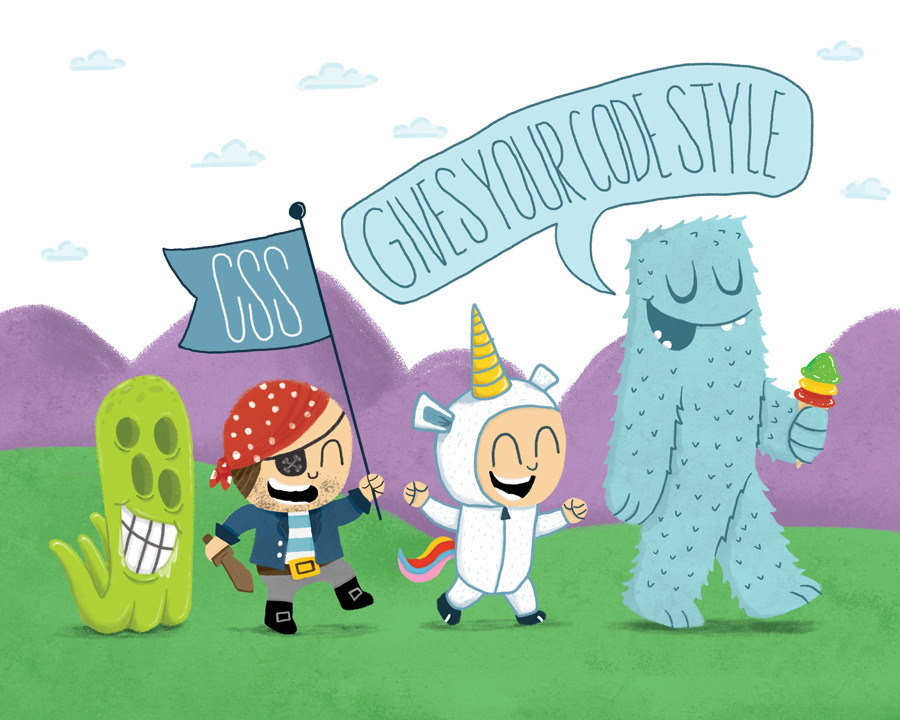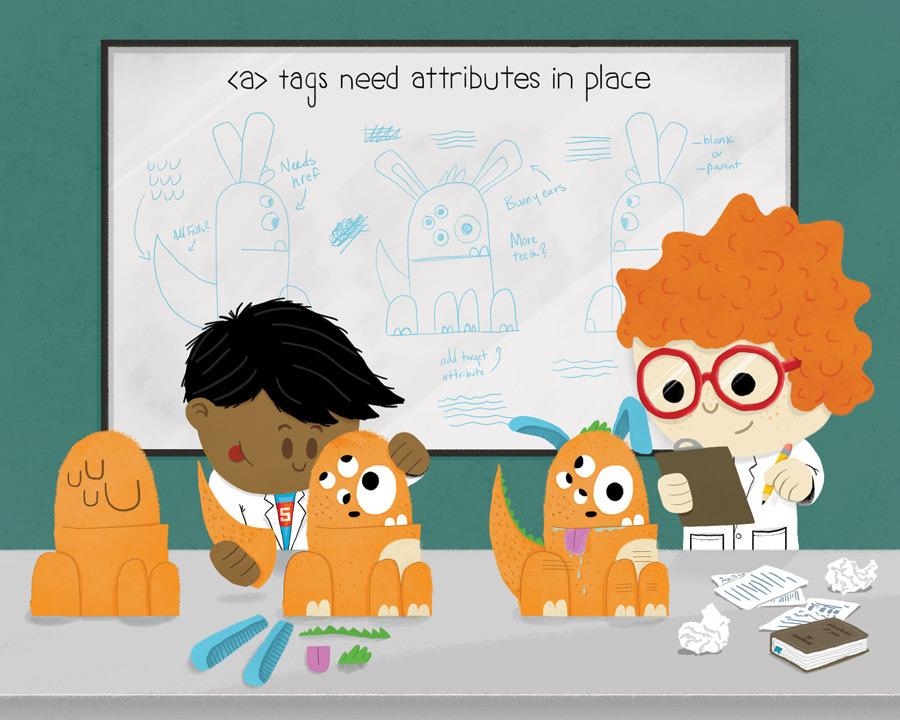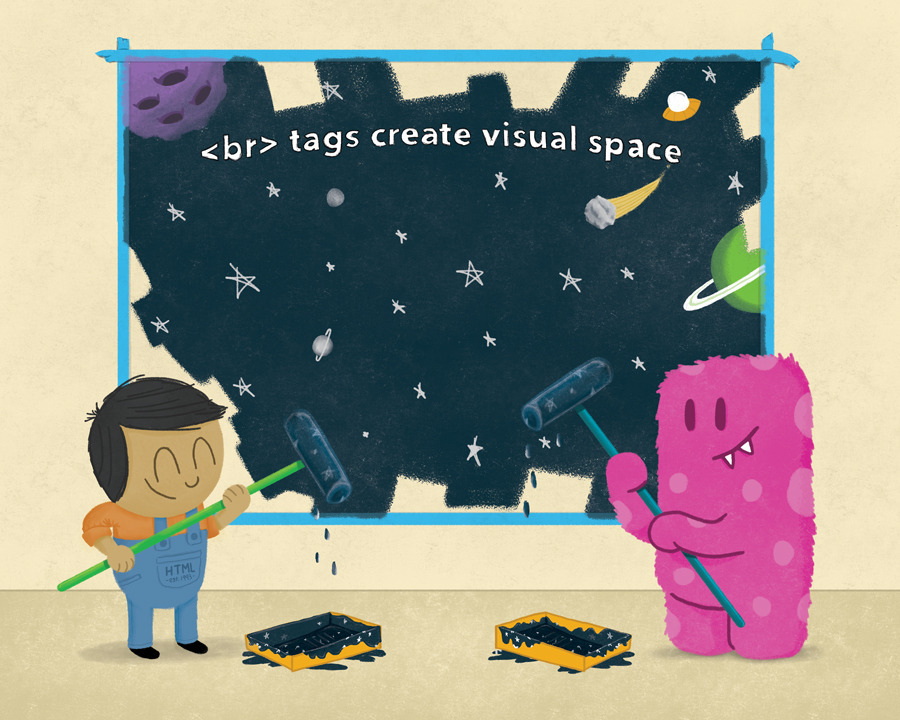
On one page, you’ll see an illustration of kid scientists assembling multi-eyed orange creatures. On another, an amicable blue furry creature leads a march of kids and an alien. At first glance, these look like pages from a normal children’s fantasy book. Look again and you’ll realize these are all characters on a journey decorated with HTML tags.
The Wonderful World of Creatures & Code (WWoCC) is an A-Z style kid’s book with the purpose of introducing children to code. But it’s not available for purchase just yet. It’s currently on Kickstarter until Oct. 31 with a goal of $25,000.
The book was born out of a gift-searching trip that left Amie Pascal and her wife, Heather O. Petrocelli, empty-handed. They were invited to a baby shower for a friend who was a developer and thought a kid’s book about code would be the perfect present. After searching online and in bookstores, they found nothing.
Instead, they wrote their own book in PDF form with colored words on a black background. Everyone who saw the book encouraged them to take the idea further, and The Wonderful World of Creatures & Code was the result. They knew they didn’t have to dumb things down; they just had to make it accessible and incorporate play, what they felt was one of the most important things in a child’s development.
“We felt like it would be a magical moment if something playful and fun could overlap with a seemingly hard thing like code,” Pascal, an executive producer at digital creative agency Instrument, told Mashable. “We thought kids really like creatures and monsters and imaginative worlds, and a lot of times people think code is like magic. You know, it just happens like magic. So we thought, well we’ll create this fantastical world and put kids and creatures in it together and that’s what’s teaching kids about getting familiar with code.”
Between the pages
Pascal and Petrocelli, who both live in Portland, searched for a year before they found Jason Heglund, a graphic designer who could bring their vision to vivid life. WWoCC illustrates 26 essential HTML tags and fundamental codes in building websites, from “a” tags to “break” tags, and uses rhyme to stay true to the personality and simplicity of a children’s book.

The images aren’t just for aesthetics, though. They also symbolize code concepts. On the page for the “a” tag, the little scientists depicted are putting together parts of a creature as you would add attributes to an “a” tag to complete a webpage. The whiteboard behind them has sketches of the creatures with little notes like “needs href,” a little easter egg for parents who have a little more advanced knowledge about code.
There are other layers of surprises like this, too. One character’s overalls swaps out the signature OshKosh B’gosh logo for one that says “HTML est. 1993.” There are nods to founders of modern technology, such as Tim Berners-Lee and Ada Lovelace. “It’s like in Pixar and Disney movies now; there are always those jokes that are there for parents,” Pascal said. “You want to have a thing to make it more fun for them, so for us to have developers and engineers look at it and be like oh my god, that’s a great reference.”

The next chapter
This isn’t the first programming book for kids, though. Code Babies is a publisher for kids’ books on code, with titles such as ABCs of the Web and HTML for Babies. Another book, Hello Ruby, got its start on Kickstarter in 2014, aiming to introduce the basics of coding through the narrative of a young girl on an adventure. Beyond these, however, the pool of children’s code books is sparse. And not many capture the whimsical personality found in WWoCC.
Pascal said this project is their first step in supporting the growing effort to expose more kids to computer science. In September, on the coast opposite of where they live, New York City Mayor Bill de Blasio announced “Computer Science for All,” an initiative to provide computer science in all of the city’s public schools within 10 years.
In 2013, President Obama urged the importance of computer science in a YouTube speech to kick off the Hour of Code program as part of Computer Science Education Week, an annual program to encourage computer science in grades K-12. Hour of Code is a movement bringing a one-hour introductory session to students in more than 180 countries.
Pascal and Petrocelli aren’t developers or engineers, but they understand the need for learning code as a foundational skill. “We know how to build a website and we know the basics of what’s behind the scenes, so we can kind of operate in our increasingly technical world, and that is going to be more and more of the norm for people as they go through life,” Pascal said.
They don’t, however, think computer science should come at the expense of other important basics, such as math, reading or the arts. But Pascal said it’s a critical addition to children’s development. “You have to know how to read to get along in our world and to add coding as a new important edition to the ABCs and 123s is like new literacy,” Pascal said. “To us, it’s not either/or that kids need exposure to code … We don’t expect kids are going to start coding once they read this book, just as they’re not going to write War and Peace after learning their ABCs, but it’s just getting them familiar and making it accessible and having those building blocks.”
Pascal and Petrocelli have finished writing and sketching out WWoCC, but they need crowdfunding to help Heglund finish illustrating the pages, as well as for printing and shipping the books. The Kickstarter has raised $14,738 at the time of publication, with 15 days left to go.